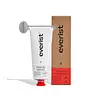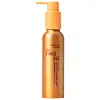What's inside
What's inside
 Key Ingredients
Key Ingredients

 Benefits
Benefits

 Concerns
Concerns

 Ingredients Side-by-side
Ingredients Side-by-side

Aloe Barbadensis Leaf Juice
Skin ConditioningGlycerin
HumectantCetearyl Alcohol
EmollientCaprylic/Capric Triglyceride
MaskingCetyl Alcohol
EmollientCitrus Aurantium Dulcis Peel Oil
MaskingLimonene
PerfumingBehentrimonium Chloride
PreservativeHydroxypropyl Starch Phosphate
Brassicyl Isoleucinate Esylate
Emulsion StabilisingAdansonia Digitata Seed Oil
EmollientAlanine
MaskingArginine
MaskingAspartic Acid
MaskingCitric Acid
BufferingBrassica Alcohol
EmollientButyrospermum Parkii Butter
Skin ConditioningCocos Nucifera Oil
MaskingCocos Nucifera Fruit Juice
EmollientCucurbita Pepo Seed Oil
EmollientGlycine
BufferingGuar Hydroxypropyltrimonium Chloride
Skin ConditioningCaprylhydroxamic Acid
Histidine
HumectantIlex Paraguariensis Leaf Extract
PerfumingIsoleucine
Skin ConditioningPanthenol
Skin ConditioningPCA
HumectantPhenylalanine
MaskingProline
Skin ConditioningSerine
MaskingSodium PCA
HumectantPropanediol
SolventSodium Lactate
BufferingIsopropyl Alcohol
SolventThreonine
1,2-Hexanediol
Skin ConditioningValine
MaskingWithania Somnifera Root Extract
Skin ConditioningSodium Benzoate
MaskingSodium Hydroxide
BufferingPotassium Sorbate
PreservativeRosmarinus Officinalis Leaf Oil
MaskingSalvia Sclarea Oil
MaskingMentha Piperita Oil
MaskingCitrus Aurantium Bergamia Fruit Oil
MaskingAloe Barbadensis Leaf Juice, Glycerin, Cetearyl Alcohol, Caprylic/Capric Triglyceride, Cetyl Alcohol, Citrus Aurantium Dulcis Peel Oil, Limonene, Behentrimonium Chloride, Hydroxypropyl Starch Phosphate, Brassicyl Isoleucinate Esylate, Adansonia Digitata Seed Oil, Alanine, Arginine, Aspartic Acid, Citric Acid, Brassica Alcohol, Butyrospermum Parkii Butter, Cocos Nucifera Oil, Cocos Nucifera Fruit Juice, Cucurbita Pepo Seed Oil, Glycine, Guar Hydroxypropyltrimonium Chloride, Caprylhydroxamic Acid, Histidine, Ilex Paraguariensis Leaf Extract, Isoleucine, Panthenol, PCA, Phenylalanine, Proline, Serine, Sodium PCA, Propanediol, Sodium Lactate, Isopropyl Alcohol, Threonine, 1,2-Hexanediol, Valine, Withania Somnifera Root Extract, Sodium Benzoate, Sodium Hydroxide, Potassium Sorbate, Rosmarinus Officinalis Leaf Oil, Salvia Sclarea Oil, Mentha Piperita Oil, Citrus Aurantium Bergamia Fruit Oil
Aloe Barbadensis Leaf Juice
Skin ConditioningLactobacillus
Skin ConditioningBrassicamidopropyl Dimethylamine
Skin ConditioningCocos Nucifera Oil
MaskingWater
Skin ConditioningGlycerin
HumectantPyrus Malus Fruit Extract
Skin ConditioningBrassica Alcohol
EmollientLactic Acid
BufferingVinegar
Cetearyl Alcohol
EmollientDisunfloweroylethyl Dimonium Chloride
Hydroxypropyl Starch Phosphate
Brassicyl Valinate Esylate
EmollientHydroxypropyltrimonium Inulin
Emulsion StabilisingSodium PCA
HumectantHydrolyzed Yeast Protein
Skin ConditioningPassiflora Edulis Seed Oil
EmollientOryza Sativa Bran Oil
EmollientEuterpe Oleracea Fruit Oil
Skin ConditioningSunflower Seed Oil Glycerides
EmollientPolyglycerin-3
HumectantPolyglyceryl-3 Lactate/Laurate
CleansingGuar Hydroxypropyltrimonium Chloride
Skin ConditioningCalcium Gluconate
HumectantButylene Glycol
HumectantLauryl Lactyl Lactate
Skin ConditioningTrisodium Ethylenediamine Disuccinate
1,2-Hexanediol
Skin ConditioningSodium Benzoate
MaskingPotassium Sorbate
PreservativeCitric Acid
BufferingLimonene
PerfumingParfum
MaskingAloe Barbadensis Leaf Juice, Lactobacillus, Brassicamidopropyl Dimethylamine, Cocos Nucifera Oil, Water, Glycerin, Pyrus Malus Fruit Extract, Brassica Alcohol, Lactic Acid, Vinegar, Cetearyl Alcohol, Disunfloweroylethyl Dimonium Chloride, Hydroxypropyl Starch Phosphate, Brassicyl Valinate Esylate, Hydroxypropyltrimonium Inulin, Sodium PCA, Hydrolyzed Yeast Protein, Passiflora Edulis Seed Oil, Oryza Sativa Bran Oil, Euterpe Oleracea Fruit Oil, Sunflower Seed Oil Glycerides, Polyglycerin-3, Polyglyceryl-3 Lactate/Laurate, Guar Hydroxypropyltrimonium Chloride, Calcium Gluconate, Butylene Glycol, Lauryl Lactyl Lactate, Trisodium Ethylenediamine Disuccinate, 1,2-Hexanediol, Sodium Benzoate, Potassium Sorbate, Citric Acid, Limonene, Parfum
Ingredients Explained
These ingredients are found in both products.
Ingredients higher up in an ingredient list are typically present in a larger amount.
1,2-Hexanediol is a synthetic liquid and another multi-functional powerhouse.
It is a:
- Humectant, drawing moisture into the skin
- Emollient, helping to soften skin
- Solvent, dispersing and stabilizing formulas
- Preservative booster, enhancing the antimicrobial activity of other preservatives
Aloe Barbadensis Leaf Juice comes from leaves of the aloe plant. Aloe Barbadensis Leaf Juice is best known for helping to soothe sunburns. It is also anti-inflammatory, moisturizing, antiseptic, and can help heal wounds.
Aloe is packed with good stuff including Vitamins A, C, and E. These vitamins are antioxidants, which help fight free-radicals and the damage they may cause. Free-radicals are molecules that may damage your skin cells, such as pollution.
Aloe Barbadensis Leaf Juice also contains sugars. These sugars come in the form of monosaccharides and polysaccharides, folic acid, and choline. These sugars are able to help bind moisture to skin.
It also contains minerals such as calcium, 12 anthraquinones, fatty acids, amino acids, and Vitamin B12.
Learn more about Aloe Barbadensis Leaf JuiceBrassica Alcohol isn't fungal acne safe.
Cetearyl alcohol is a mixture of two fatty alcohols: cetyl alcohol and stearyl alcohol. It is mainly used as an emulsifier. Emulsifiers help prevent the separation of oils and products. Due to its composition, it can also be used to thicken a product or help create foam.
Cetearyl alcohol is an emollient. Emollients help soothe and hydrate the skin by trapping moisture.
Studies show Cetearyl alcohol is non-toxic and non-irritating. The FDA allows products labeled "alcohol-free" to have fatty alcohols.
This ingredient is usually derived from plant oils such as palm, vegetable, or coconut oils. There is debate on whether this ingredient will cause acne.
Due to the fatty acid base, this ingredient may not be Malassezia folliculitis safe.
Learn more about Cetearyl AlcoholCitric Acid is an alpha hydroxy acid (AHA) naturally found in citrus fruits like oranges, lemons, and limes.
Like other AHAs, citric acid can exfoliate skin by breaking down the bonds that hold dead skin cells together. This helps reveal smoother and brighter skin underneath.
However, this exfoliating effect only happens at high concentrations (20%) which can be hard to find in cosmetic products.
Due to this, citric acid is usually included in small amounts as a pH adjuster. This helps keep products slightly more acidic and compatible with skin's natural pH.
In skincare formulas, citric acid can:
While it can provide some skin benefits, research shows lactic acid and glycolic acid are generally more effective and less irritating exfoliants.
Most citric acid used in skincare today is made by fermenting sugars (usually from molasses). This synthetic version is identical to the natural citrus form but easier to stabilize and use in formulations.
Read more about some other popular AHA's here:
Learn more about Citric AcidCocos Nucifera Oil is obtained from the kernels of the coconut fruit. In other words, this is coconut oil.
Coconut Oil is rich in fatty acids with lauric acid making up the majority of these. It also contains linoleic acid. Due to this high fatty acid content, coconut oil helps trap moisture and soften skin.
Despite being antibacterial, coconut oil may not be great for acne-prone skin. It is comedogenic and may clog pores. This ingredient may not be safe for malassezia or fungal acne.
Note: Coconut Oil should not replace your sunscreen for UV protection. Studies show it only blocks about 20% of UV.
This oil is non-volatile and has a light scent.
The term 'fragrance' is not regulated in many countries. In many cases, it is up to the brand to define this term. For instance, many brands choose to label themselves as "fragrance-free" because they are not using synthetic fragrances. However, their products may still contain ingredients such as essential oils that are considered a fragrance.
Learn more about Cocos Nucifera OilGlycerin is already naturally found in your skin. It helps moisturize and protect your skin.
A study from 2016 found glycerin to be more effective as a humectant than AHAs and hyaluronic acid.
As a humectant, it helps the skin stay hydrated by pulling moisture to your skin. The low molecular weight of glycerin allows it to pull moisture into the deeper layers of your skin.
Hydrated skin improves your skin barrier; Your skin barrier helps protect against irritants and bacteria.
Glycerin has also been found to have antimicrobial and antiviral properties. Due to these properties, glycerin is often used in wound and burn treatments.
In cosmetics, glycerin is usually derived from plants such as soybean or palm. However, it can also be sourced from animals, such as tallow or animal fat.
This ingredient is organic, colorless, odorless, and non-toxic.
Glycerin is the name for this ingredient in American English. British English uses Glycerol/Glycerine.
Learn more about GlycerinThis ingredient is derived from guar gum.
It is a conditioning ingredient, meaning it helps soften skin and hair.
Hydroxypropyl Starch Phosphate is a modified starch used to help thicken a product.
It is also used in foods.
Limonene is a fragrance that adds scent and taste to a formulation.
It's found in the peel oil of citrus fruits and other plants such as lavender and eucalyptus. The scent of limonene is generally described as "sweet citrus".
Limonene acts as an antioxidant, meaning it helps neutralize free radicals.
When exposed to air, oxidized limonene may sensitize the skin. Because of this, limonene is often avoided by people with sensitive skin.
The term 'fragrance' is not regulated in many countries. In many cases, it is up to the brand to define this term. For instance, many brands choose to label themselves as "fragrance-free" because they are not using synthetic fragrances. However, their products may still contain ingredients such as essential oils that are considered a fragrance.
Learn more about LimonenePotassium Sorbate is a preservative used to prevent yeast and mold in products. It is commonly found in both cosmetic and food products.
This ingredient comes from potassium salt derived from sorbic acid. Sorbic acid is a natural antibiotic and effective against fungus.
Both potassium sorbate and sorbic acid can be found in baked goods, cheeses, dried meats, dried fruit, ice cream, pickles, wine, yogurt, and more.
You'll often find this ingredient used with other preservatives.
Learn more about Potassium SorbateSodium Benzoate is a preservative. It's used in both cosmetic and food products to inhibit the growth of mold and bacteria. It is typically produced synthetically.
Both the US FDA and EU Health Committee have approved the use of sodium benzoate. In the US, levels of 0.1% (of the total product) are allowed.
Sodium benzoate works as a preservative by inhibiting the growth of bacteria inside of cells. It prevents the cell from fermenting a type of sugar using an enzyme called phosphofructokinase.
It is the salt of benzoic acid. Foods containing sodium benzoate include soda, salad dressings, condiments, fruit juices, wines, and snack foods.
Studies for using ascorbic acid and sodium benzoate in cosmetics are lacking, especially in skincare routines with multiple steps.
We always recommend speaking with a professional, such as a dermatologist, if you have any concerns.
Learn more about Sodium BenzoateSodium PCA is the sodium salt of pyroglutamic acid. It is naturally occurring in our skin's natural moisturizing factors where it works to maintain hydration.
The PCA stands for pyrrolidone carboxylic acid, a natural amino acid derivative.
This ingredient has skin conditioning, anti-inflammatory, and humectant properties. Humectants help hydrate your skin by drawing moisture from the air. This helps keep your skin moisturized.
Learn more about Sodium PCA